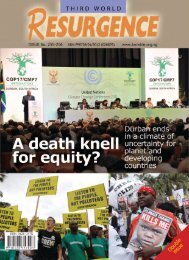Plantations, poverty and power - Critical Information Collective
Plantations, poverty and power - Critical Information Collective
Plantations, poverty and power - Critical Information Collective
You also want an ePaper? Increase the reach of your titles
YUMPU automatically turns print PDFs into web optimized ePapers that Google loves.
41<br />
impact of the plantations on water supply. Woodmark found that Sappi’s replanting procedures did not<br />
comply with national regulations requiring a 30-metre-wide strip along streams. In one place trees had<br />
been planted too close to a stream. In another, a stream was channelled across a road instead of under<br />
it. 176<br />
In his 2004 report, Wally Menne of Timberwatch found that the plantations are affecting the flow of<br />
water. Menne interviewed Rex Brown of Environmental Consultancy Services, a Swazil<strong>and</strong> consulting<br />
firm which works for the government <strong>and</strong> private companies. Brown told him that he considers<br />
plantations to be one of the causes of water shortages in the country. “The plantations occur in important<br />
upl<strong>and</strong> catchments – essential areas for the provision of water for equally important irrigation activities in<br />
the Swazil<strong>and</strong> Lowveld,” Brown said. 177<br />
During their assessment, Woodmark spoke to a local farmer, Peter George, whose l<strong>and</strong> is next to one of<br />
Sappi’s plantations. “Due to the planting of pine trees since 1989 . . . the natural flow of water in the<br />
streams was severely depleted,” Peter George told Woodmark.<br />
Woodmark chose to ignore what Peter George told them during the assessment, because he has taken out<br />
a legal case against Sappi. “The issue regarding the reduction of water flow caused by the planting of<br />
trees <strong>and</strong> the subsequent claim is ‘sub judice’ <strong>and</strong> is therefore under judicial consideration,” Woodmark’s<br />
assessors wrote in the Public Summary. Under the sub judice (from the Latin, “under judgement”) rule in<br />
British law it can be an offence to publicly discuss current or upcoming court cases. The rule is intended<br />
to protect the right of defendants to a fair trail, but in this case Woodmark is hiding behind the sub judice<br />
rule to prevent legitimate debate. When Woodmark’s assessors revisited Swazil<strong>and</strong> in 2007 for their<br />
annual audit of Sappi’s plantations, they did not invite Peter George to their stakeholder meeting. Neither<br />
did they visit his farm. 178<br />
Peter George bought the Elangeni Farm in the mid-1970s <strong>and</strong> started to farm the l<strong>and</strong>. He grew<br />
vegetables <strong>and</strong> some acacia <strong>and</strong> eucalyptus trees. When he started farming, there was plenty of water. In<br />
the mid-1980s, the Usutu Pulp Company started planting the hills next to his farm with pine plantations.<br />
George was forced to stop farming when the streams on his farm dried up.<br />
I visited Peter George’s farm in November 2007 with colleagues from the World Rainforest Movement.<br />
George showed us where the Usutu Pulp Company had planted trees right through the streams which had<br />
provided his farm with water. Several years ago, Sappi cleared the plantations <strong>and</strong> the streams started to<br />
recover, although it was 18 months before one of the streams started to flow again. Sappi has not<br />
replanted right up to the streams, but neither has it kept the 30-metre-wide strips along the streams which<br />
are required under Swazil<strong>and</strong>’s regulations. 179<br />
176 “Woodmark Forest Certification Public Report, Sappi Usutu”, Woodmark, Soil Association, July 2006.<br />
http://www.organicweek.org/web/sa/saweb.nsf/librarytitles/22D0E.HTMl/$file/Usutu%20FM%20S1%20report%20FINAL<br />
.xls<br />
177 Wally Menne (2004) “Timber <strong>Plantations</strong> in Swazil<strong>and</strong>: An investigation into the environmental <strong>and</strong> social impacts<br />
of large-scale timber plantations in Swazil<strong>and</strong>”, Timberwatch Coalition <strong>and</strong> World Rainforest Movement, December 2004,<br />
page 24. http://www.wrm.org.uy/countries/Swazil<strong>and</strong>/<strong>Plantations</strong>.pdf<br />
178 Chris Lang (2007) “Swazil<strong>and</strong>: Woodmark <strong>and</strong> Sappi ignore the lessons from a neighbouring farmer”, World<br />
Rainforest Movement Bulletin 125, December 2007. http://chrislang.org/2007/12/20/swazil<strong>and</strong>-woodmark-<strong>and</strong>-sappiignore-the-lessons-from-a-neighbouring-farmer/<br />
179 For more information about Peter George, see “Just Add Water”, a leaflet that Peter George wrote in November















